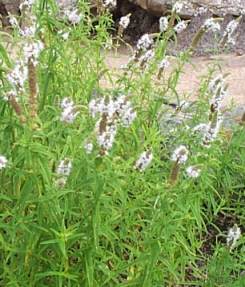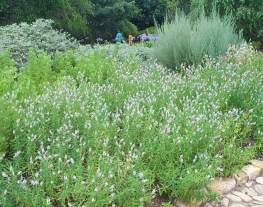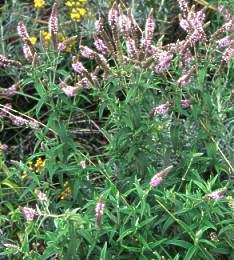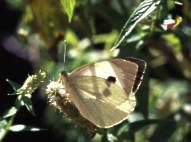Mentha longifolia
Mentha longifolia L.
Family: Lamiaceae
Common names: wild mint (Eng.); kruisement, balderjan, ballerja (Afr.); koena-ya-thaba, bohatsu (Southern Sotho); inixina, inzinziniba (Xhosa); ufuthana lomhlanga (Zulu)
Introduction
With its strong mint smell and taste, this herb has found its way into homes for centuries where it has been used in the kitchen and as a medicine. There are many different mints; different species, hybrids and special selections that are grown all over the world. Most of them are water lovers and are usually found growing in wet and damp places.

Description
Description
Mentha longifolia or wild mint is a fast-growing, perennial herb that has creeps along an underground rootstock. It can reach up to 1.5 m high in favourable conditions, but is usually between 0.5-1 m high and even shorter in dry conditions. Strongly aromatic, the leaves are formed in pairs opposite each other along the square-shaped stem. The soft, lanceolate leaves (long and narrow with a sharp point) are between 45-100 mm long and 7-20 mm wide. The leaves are usually coarsely hairy and the edges sparsely toothed. The colour of the leaves varies from light and dark green to grey. The small flowers of Mentha longifolia are crowded into spikes at the tip of the stems. Varying in colour from white to mauve, this wild mint flowers throughout the summer months (November to April).
Distribution and habitat
Distribution description
Two mint species are indigenous to South Africa, Mentha longifolia and M. aquatica (wild water mint). Both are quite commonly found in marshes and along streams, from the Cape through Africa and Europe. M. longifolia (longifolia meaning long leaves) is identified by its stalkless leaves and white to mauve flowers that are grouped in a long spike. The leaves of M. aquatica (aquatica meaning living in water) are broader and more egg-shaped, whereas the flowerheads are roundish whorls (approximately 25 mm in diameter), pink or mauve flower clusters formed one above the other.
In South Africa, three different subspecies of Mentha longifolia are recognized.
- M. longifolia subsp. wissi (Cape velvet mint) is known from only two places, the one near Brandberg in Namibia and the other near Garies in Namaqualand. The long and thin, grey-green leaves of subsp. wissi are said to be unpleasantly aromatic.
- M. longifolia subsp. capensis (balderjan), with a strong peppermint scent, is the most widespread and occurs from Calvinia down to the Cape Peninsula through the Eastern Cape, Lesotho, Orange Free State, KwaZulu-Natal to Gauteng and Limpopo the Northern Province.
- The distribution of M. longifolia subsp. polyadena (spearmint) is along two disjunct areas, the first from Gauteng, Swaziland, northern KwaZulu Natal, eastern Free State and northern Lesotho and then with a long jump down to the southern Cape, it is found again between Humansdorp and the Swartberg.
Derivation of name and historical aspects
History
The large mint family, Lamiaceae, with about 250 genera and 6 700 species, include many well-known herbs and garden plants such as like lavender, sage, basil, rosemary and mint. Mentha (Latin for mint) is a cosmopolitan genus with about 20 to 30 species that are mainly found in temperate regions. The identification of the mints can be quite difficult for they are extremely variable and easily hybridized.
The many common names is a quick clue that this is a plant that means something to people, but can also be confusing. The same common name is often given to different plants or the same plant may have different common names in different areas and languages. The original Nama name meant 'something that grows close to water' (Rood 1994). In England, Mentha longifolia is known as horse mint because the leaves are usually unpleasantly scented.(Codd 1985). M. spicata, also called spearmint, is not indigenous to South Africa, but is often found as a garden escape in wet areas. This exotic mint is a very popular herb and is also cultivated commercially for its essential oils that are used medicinally and in confectionary. Cultivated in Europe since ancient times, its origin has been lost but it has managed to become naturalized throughout the world in a range of different forms (Codd 1985).
Ecology
Ecology
Bees and butterflies are attracted to the wild mint when in flower.
Uses
Use
Found in most parts of the country and easy to harvest, wild mint is a popular traditional medicine. It is mainly used for respiratory ailments but many other uses have also been recorded. It is mostly the leaves that are used, usually to make a tea that is drunk for coughs, colds, stomach cramps, asthma, flatulence, indigestion and headaches. Externally, wild mint has been used to treat wounds and swollen glands. In her book Traditional healing herbs, Margaret Roberts mentions the different uses of Mentha longifolia and M. aquatica, which are delicious in salads and vegetable dishes. She also mentions that M. longifolia subsp. capensis, with its strong smell rubbed onto the body and bedding, is used to keep mosquitoes away.

Growing Mentha longifolia
Grow
With its strong fragrance and many uses, it is worth finding a place in the garden for the wild mint. Mentha longifolia is easy to grow, with the same requirements as most mints. Mints are fast growers but seem to be always on the move. With underground runners, they disappear and pop up wherever they find a suitable spot. Heavy feeders and water lovers, mints grow in semi-shade and full sun. They do well in pots where they are contained, but need to be repotted every year or two in new compost-rich soil. Placing the pot under a tap is a good way of catching the small drips and leaks while keeping the mint moist. To encourage new fresh growth, mint should be cut back often. Mint is easy to multiply by division; the smallest piece of healthy rootstock quickly grows into a new clump with regular water and compost. Cuttings of young actively growing shoots root easily throughout the year.
References
- Codd, L.E.W. 1983. Southern African species of Mentha L. (Lamiaceae). Bothalia 14: 169-175.
- Codd, L.E.W. 1985. Lamiaceae. Flora of southern Africa 28,4. Botanical Research Institute, Pretoria.
- Goldblatt, P. & Manning, J. 2000. Wild flowers of the fairest Cape. National Botanical Institute, Cape Town.
- Goldblatt, P. & Manning, J. 2000. Cape plants. A conspectus of the Cape flora of South Africa. Strelitzia 9. National Botanical Institute, Cape Town and Missouri Botanical Gardens.
- Outdtshoorn, B., Gericke, N. & Van Wyk, B. 1997. Medicinal plants of South Africa. Briza Publications, Pretoria.
- Pooley, E. 2003. Mountain flowers. The Flora Publications Trust, Durban.
- Roberts, M. 1990. Indigenous healing plants. Southern Book Publishers, Pretoria.
- Rood, B. 1994. Uit die veld apteek. Tafelberg, Cape Town.
- Van Wyk, B. & Gericke, N. 2000. People's plants. Briza Publications, Pretoria.
Credits
Liesl van der Walt
Kirstenbosch
January 2004
Plant Attributes:
Plant Type: Perennial
SA Distribution: Eastern Cape, Free State, Gauteng, KwaZulu-Natal, Limpopo, Mpumalanga, Western Cape
Soil type: Sandy, Loam
Flowering season: Early Summer
PH: Neutral
Flower colour: White, Mauve/Lilac
Aspect: Full Sun, Morning Sun (Semi Shade), Afternoon Sun (Semi Shade)
Gardening skill: Easy
Special Features:
Horticultural zones












Rate this article
Article well written and informative
Rate this plant
Is this an interesting plant?
Login to add your Comment
Back to topNot registered yet? Click here to register.